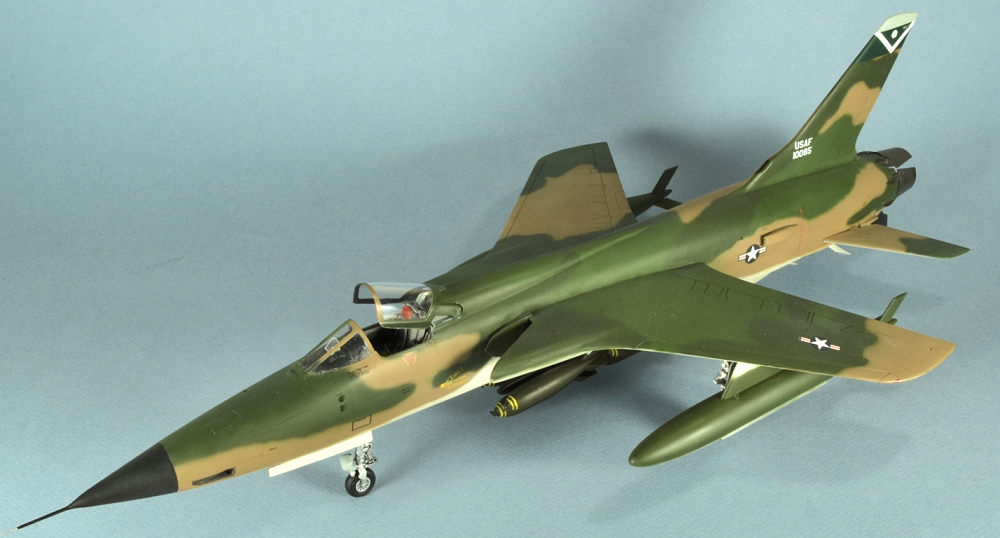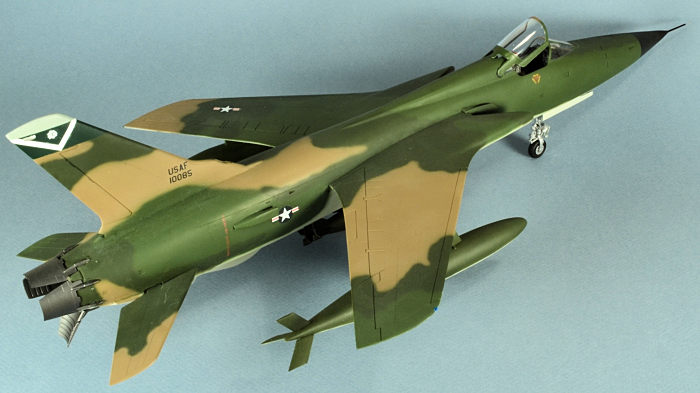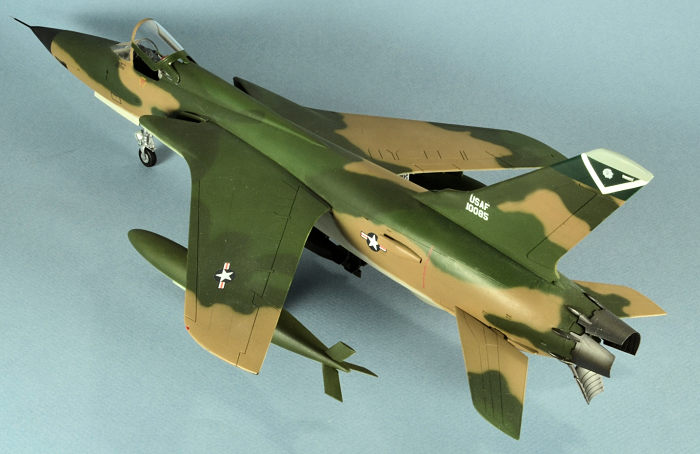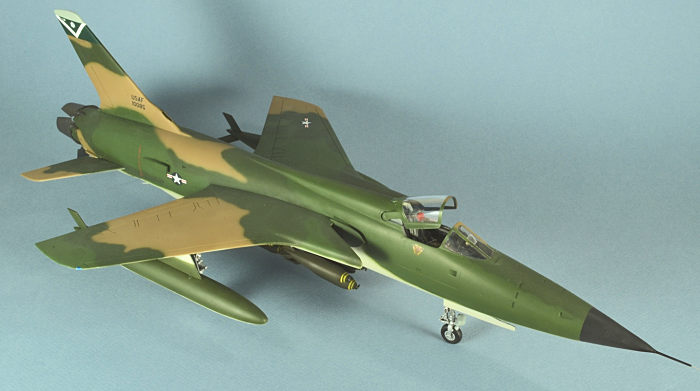
Monogram 1/48 F-105D Thunderchief
| KIT #: | 5812 |
| PRICE: | Currently OOP |
| DECALS: | One option |
| REVIEWER: | Ben Brown |
| NOTES: | Black Box cockpit, Master Models pitot tube |

| HISTORY |
Originally conceived as a replacement for the Republic F-84F Thunderstreak, the YF-105A was first flown on October 22, 1955. Only two YF-105As were built, and the Air Force accepted the F-105B into service in May 1958. The 335th Fighter Day Squadron, later redesignated 335th Tactical Fighter Squadron, was the first operational unit to receive the F-105, the first arriving in August 1958. Over the next several years, the wing carried out testing and bore the brunt of the developmental problems the big jet encountered during its early days in service. The F-105B never flew in combat, but the 4th was put on alert in Florida during the Cuban Missile Crisis. By 1961, the 4th TFW had begun phasing out the F-105B in favor of the all-weather F-105D, with all of the B-models gone by 1964. Other units in Europe and Asia began receiving F-105Ds by mid-1962.
The F-105 is best known for its service in Southeast Asia (SEA), where it
flew more missions to North Vietnam than any other aircraft, and consequently
suffered more losses. Most of the F-105ís missions were flown at low level into
heavily-defended target areas. A total of 395 F-105s were lost in Southeast
Asia, and of those, 334 were due to enemy action. Even though it was primarily a
ground attack aircraft, Thuds accounted for 27.5 North Vietnamese aircraft while
losing 17 Thuds to enemy MiGs. The last F-105D unit, the 355th TFW, began
withdrawing from SEA in October 1970, while the two-seat F-105G Wild
 Weasels
remained until the end of the war. The USAF transferred the war weary Thuds to
the Air National Guard and Air Force Reserves, where they continued to serve
until they were finally retired in 1984.
Weasels
remained until the end of the war. The USAF transferred the war weary Thuds to
the Air National Guard and Air Force Reserves, where they continued to serve
until they were finally retired in 1984.
The 4th TFW deployed to Yokota AB, Japan in July 1965 under Operation Two Buck, with the 334th TFS transferring to Takhli RTAFB, Thailand on August 28. They began combat operations immediately, and suffered their first loss on Sept. 20, when Capt. Willis Forby was shot down and taken prisoner. The 335th TFS joined the 334th in November. The 335th returned to Seymour Johnson AFB on December 15, 1965, leaving their Thuds and ground crews behind. The 333rd TFS took over the 335thís assets and was later permanently reassigned to the 355th TFW. The 334th TFS returned home on October 10, 1966. During its deployment, the 4th TFW lost eight F-105s and four pilots, with two killed and two captured. The 334th TFS also left their Thuds in Takhli, and the wing began transitioning into the F-4D Phantom II, receiving their first F-4D in January, 1967.
| THE KIT |
Monogramís F-105D kit was introduced during the mid-1980s, and has been reissued several times. Molded in dark green plastic, the kit has Monogramís typical raised panel lines, good detail, and good fit. Ordnance includes six 750 lb. bombs and a couple of 500 pounders, plus two drop tanks. The shape and dimensions are generally accurate, although the kit shares its wings with the F-105G kit, so there are some Wild Weasel antenna bumps that need to be removed. There are also four antennae on the nose that can be removed in a couple of minutes. The kit represents a Thud late in its career, with the radar warning antennae on the nose and tail, strike camera, hydraulic line fairing between the cockpit and the tail, and reinforcements on the wings.
 The cockpit is typical Monogram in that itís
accurate and can be dressed up with a little detail painting. The gear wells and
struts are also well-detailed. One would think the long, spindly main gear
struts would have trouble supporting the weight of the model, but Iíve had one
sitting on my shelf for over 20 years with no bending or warping of the struts.
It does tend to shimmy when my 60 pound Lab runs through the room, something
this current model, with its metal struts, doesnít do.
The cockpit is typical Monogram in that itís
accurate and can be dressed up with a little detail painting. The gear wells and
struts are also well-detailed. One would think the long, spindly main gear
struts would have trouble supporting the weight of the model, but Iíve had one
sitting on my shelf for over 20 years with no bending or warping of the struts.
It does tend to shimmy when my 60 pound Lab runs through the room, something
this current model, with its metal struts, doesnít do.
Much has been said about the shape of the kitís nose, especially the radome. Our IPMS chapter once visited Seymour Johnson AFB to present some models to the 4thís Wing Commander. One of our members brought along a Monogram F-105, which gave us the opportunity to compare the kit with the real Thud on display at the base. To my middle-aged-but-corrected-to-20/20 eyes, the kitís nose doesnít appear to be as far off as has been previously stated. Granted, the radome is a bit undersized in diameter where it joins the fuselage, but it does have the barely-noticeable curve that switches to a pure cone shape for the most-forward 1/4 of its length, just like the real radome. The kit pitot tube is overscale and isnít quite in the center of the point of the radome, which also throws off the looks of the nose. The kitís profile doesnít match with drawings in a couple of well-known references, but weíve seen on far too many occasions that one canít always trust drawings. My theory is that photos tend to make the real jetís radome profile seem more curved than it really is, because up close, the effect is very subtle, and Monogramís radome actually seems to be pretty good.
| CONSTRUCTION |
I wanted to build my kit as
a mid-1960s, newly-camouflaged jet for my long-term project of building all
aircraft types flown by the 4th TFW, so I was going to have to do a
little backdating. I started by cutting off the hydraulic fairing that runs
between the cockpit and the fin. I also sanded off the raised reinforcements on the wings, the strike camera bulge under the nose, and the RWR antenna fairings
on the tail. I got a little carried away with the sandpaper, and removed the
raised panels on the aft fuselage, where the cooling scoops attach. These panels
appear to have been added at the same time as the scoops, which was around
mid-1965. I also filled the 25 rectangular vent holes on the left side of the
nose and the five on the right side. While I had the filler out, I took care of
the sink holes that mar the surface of the aft fuselage air scoops. I cut out a
rectangle of plastic to the right of the ventral fin and built up the louvered
vent that should be there using thin styrene sheet and boxed it in from behind
with scrap styrene. Because I was doing so much sanding on the airframe, I ended
up having to rescribe the entire model. Next to Monogramís F-101B, this kit is
probably the hardest Iíve rescribed, because it seemed like the entire airplane
was made up of nothing but small, oddly-shaped panels.
the wings, the strike camera bulge under the nose, and the RWR antenna fairings
on the tail. I got a little carried away with the sandpaper, and removed the
raised panels on the aft fuselage, where the cooling scoops attach. These panels
appear to have been added at the same time as the scoops, which was around
mid-1965. I also filled the 25 rectangular vent holes on the left side of the
nose and the five on the right side. While I had the filler out, I took care of
the sink holes that mar the surface of the aft fuselage air scoops. I cut out a
rectangle of plastic to the right of the ventral fin and built up the louvered
vent that should be there using thin styrene sheet and boxed it in from behind
with scrap styrene. Because I was doing so much sanding on the airframe, I ended
up having to rescribe the entire model. Next to Monogramís F-101B, this kit is
probably the hardest Iíve rescribed, because it seemed like the entire airplane
was made up of nothing but small, oddly-shaped panels.
I replaced the kit cockpit
with an old KMC cockpit I had found on sale a few years ago. The resin
instrument panel looked pretty good, and I dressed it up by filling the tape
instruments, the ADI, and HSI with white typewriter correction fluid to level
them, then adding some instrument decals from Reheat. The other instruments were
just painted gloss black and drybrushed with white, since I didnít feel like
punching out and applying a dozen or so tiny instrument decals. I didnít use the
gun sight part, because it has the displays for the radar warning gear that was
not in use in 1965. I removed the kit gun sight details and scratchbuilt a new
sight after the fuselage halves had been joined. The fit of the cockpit tub
wasnít very good, and I had to fill some gaps between the aft bulkhead and the
fuselage sides after the fuselage halves were glu ed together.
ed together.
Once the cockpit was installed, the kit went together pretty quickly, especially since I didnít have to worry about preserving the raised panel lines. The parts fit surprisingly well for a 1980s Monogram kit, and I used very little filler. Out of the box, the model sits on all three wheels without nose weight, but I glued a lead weight inside the radome, just to make sure. The only sanding and filling I spent a lot of time on was the radome and the intake interiors. After some test-fitting, I decided the best way to fit the radome was to attach it with the lower side lined up with the fuselage, leaving a step on the top of the nose. I then added some Tamiya putty to the top of the radome, and sanded it back, while continuing the curve of the top of the nose.
I finished sanding off the remains of the hydraulic line fairing on the fuselage spine, then blended the aft end of the cockpit fairing and the leading edge of the fin into the fuselage using half-round styrene rod, cut at an angle and sanded to shape. The small intake on the fin was larger on the unmodified Thuds, so I extended the lower end of the intake using a round file.
| COLORS & MARKINGS |
Seymour Johnson Thuds first went to war in overall silver paint, with standard TAC markings. The 335th TFS seems to have been the only squadron to carry any kind of unit markings prior to deploying to Southeast Asia, their jets having green and white bands on the nose and tail, and an Indian chiefís head on the fuselage sides, below the intakes. These markings had been replaced with a green band with a white V on the tail around the time they arrived at Yakota, Japan. The 334th TFS received a blue band with white polka dots at about the same time.
The 4thís Thuds were camouflaged starting in
1965 and kept their tail bands. One interesting thing about Thud camouflage is
that when the Air Force first started painting these jets, every 7th (or 12th,
depending on which reference you read) jet had the tan and medium green colors
swapped, which is what I decided to
 do on my model. I used Model Master enamels,
thinned with Metalizer thinner to speed drying time, and then gave the model a
couple of coats of Microscale clear gloss to give the decals a smooth surface.
do on my model. I used Model Master enamels,
thinned with Metalizer thinner to speed drying time, and then gave the model a
couple of coats of Microscale clear gloss to give the decals a smooth surface.
Decals for my model came from the scrap box, since the kit decals are generally useless. The 4th TFW left Vietnam before tail codes were introduced in 1967, although the 333rd TFS eventually wore RK codes while attached to the 355th TFW. Before tail codes, USAF aircraft had a black or white ďUSAFĒ painted on the tail over the last five of the serial number in six-inch letters and numbers. At the time, serial numbers and the USAF were white when on a green background and black when on a tan background. It seems to have taken a while for the location and size of the serial numbers to be finalized, since photos show placement sometimes varied from plane to plane and some seem to have used eight-inch number and letters painted fairly high up on the tail. The jets were painted at depots in Southeast Asia, so they didnít carry many stencils. I painted the tail band dark green (a little too dark!) and used decal film to make the white V on the tail. The particular jet I modeled had a white Indian Chiefís head on the fin, which I drew using Inkscape vector graphics freeware and had it printed by Joseph at Fireball Models.
| FINAL CONSTRUCTION |
Metal struts arenít really necessary for
this kit. The kitís plastic struts hold up just fine, they just allow the model
to wiggle a little when someone walks through the room. Iíve had another Thud
model sitting on its
 gear for 25 years and two moves, with no problems. The
landing lights on the struts were molded solid, so I drilled them out and added
some lenses from the spares box. I used the kit bombs, but removed the fuse
extenders. I replaced the kit pitot tube with a little work of art from Master
Models. The only modification I had to make was to extend the radome a little to
blend it into the new probe. My photo of 085, taken on a mission in November
1965, shows it with silver drop tanks, but I used a little artistic license and
put camouflaged tanks on my model (I think they look better!). When the F-105s
were first camouflaged, they didnít seem to have a standard way to paint the
drop tanks, so they sometimes carried the camouflage gray up the sides of the
pylon.
gear for 25 years and two moves, with no problems. The
landing lights on the struts were molded solid, so I drilled them out and added
some lenses from the spares box. I used the kit bombs, but removed the fuse
extenders. I replaced the kit pitot tube with a little work of art from Master
Models. The only modification I had to make was to extend the radome a little to
blend it into the new probe. My photo of 085, taken on a mission in November
1965, shows it with silver drop tanks, but I used a little artistic license and
put camouflaged tanks on my model (I think they look better!). When the F-105s
were first camouflaged, they didnít seem to have a standard way to paint the
drop tanks, so they sometimes carried the camouflage gray up the sides of the
pylon.
| CONCLUSIONS |
I had a good time building this classic, for less than $40 invested. Like Monogramís vs. Trumpeterís F-100D and F-106A or Hobby Bossís vs. Monogramís F-80 kits, with 1/48 F-105s, newer isnít necessarily better or more accurate. If you are looking for an inexpensive, generally accurate, and relatively easy to build 1/48 F-105, Monogram is still the way to go.
| REFERENCES |
http://en.wikipedia.org/wiki/Republic_F-105_Thunderchief
The Republic F-105 Thunderchief Wing and Squadron Histories; James Geer
Republic F-105 Thunderchief - Warbird Tech Vol. 18; Larry Davis, David Menard
F-105 Thunderchief - Walk Around No. 23; Ken Neubeck
F-105 Thunderchief Units of the Vietnam War (#84) Peter Davies
Ben Brown
16 July 2018 Copyright ModelingMadness.com Model and aftermarket parts courtesy of my
wallet. If you would like your product reviewed fairly and
fairly quickly, please
contact
the editor
or see other details in the
Note to
Contributors.
Back to the Main Page
Back to the Review
Index Page
Back to the Previews Index Page